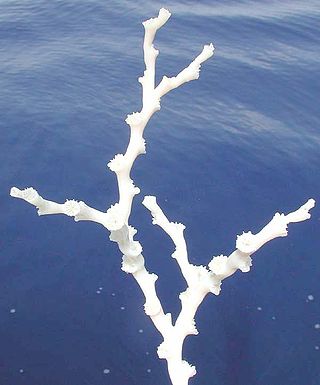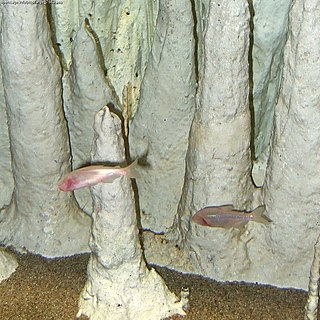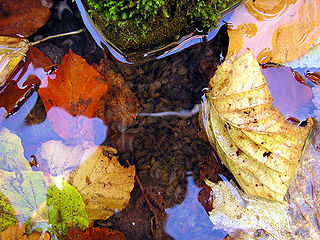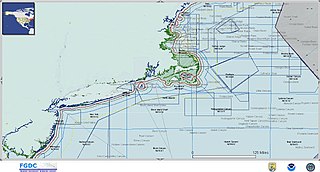
The Mariana Trench is an oceanic trench located in the western Pacific Ocean, about 200 kilometres (124 mi) east of the Mariana Islands; it is the deepest oceanic trench on Earth. It is crescent-shaped and measures about 2,550 km (1,580 mi) in length and 69 km (43 mi) in width. The maximum known depth is 10,984 ± 25 metres at the southern end of a small slot-shaped valley in its floor known as the Challenger Deep. The deepest point of the trench is more than 2 km (1.2 mi) farther from sea level than the peak of Mount Everest.

Amphipoda is an order of malacostracan crustaceans with no carapace and generally with laterally compressed bodies. Amphipods range in size from 1 to 340 millimetres and are mostly detritivores or scavengers. There are more than 9,900 amphipod species so far described. They are mostly marine animals, but are found in almost all aquatic environments. Some 1,900 species live in fresh water, and the order also includes the terrestrial sandhoppers such as Talitrus saltator and Arcitalitrus sylvaticus.

Sea pens are colonial marine cnidarians belonging to the order Pennatulacea. The order Pennatulacea, commonly known as sea pens, are colony-forming benthos belonging within subclass Octocorallia. Sea pens are found worldwide from shallow to deep waters, and they are important components in sandy and muddy environments. Thus far, there has been only one molecular study focusing on the phylogenetic relationships within the order Pennatulacea, which mainly treated deep-sea species, and thus information on shallow water species is still lacking. There are 14 families within the order and 35 extant genera; it is estimated that of 450 described species, around 200 are valid. Sea pens have a cosmopolitan distribution, being found in tropical and temperate waters worldwide, as well as from the intertidal to depths of more than 6100 m. Sea pens are grouped with the octocorals, together with sea whips (gorgonians).

The Norwegian Polar Institute is Norway's central governmental institution for scientific research, mapping and environmental monitoring in the Arctic and the Antarctic. The NPI is a directorate under Norway's Ministry of Climate and Environment. The institute advises Norwegian authorities on matters concerning polar environmental management and is the official environmental management body for Norwegian activities in Antarctica.

Lophelia pertusa, the only species in the genus Lophelia, is a cold-water coral that grows in the deep waters throughout the North Atlantic ocean, as well as parts of the Caribbean Sea and Alboran Sea. Although L. pertusa reefs are home to a diverse community, the species is extremely slow growing and may be harmed by destructive fishing practices, or oil exploration and extraction.

Prof Georg Ossian Sars HFRSE was a Norwegian marine and freshwater biologist.

Stygofauna are any fauna that live in groundwater systems or aquifers, such as caves, fissures and vugs. Stygofauna and troglofauna are the two types of subterranean fauna. Both are associated with subterranean environments – stygofauna are associated with water, and troglofauna with caves and spaces above the water table. Stygofauna can live within freshwater aquifers and within the pore spaces of limestone, calcrete or laterite, whilst larger animals can be found in cave waters and wells. Stygofaunal animals, like troglofauna, are divided into three groups based on their life history - stygophiles, stygoxenes, and stygobites.
- Stygophiles inhabit both surface and subterranean aquatic environments, but are not necessarily restricted to either.
- Stygoxenes are like stygophiles, except they are defined as accidental or occasional presence in subterranean waters. Stygophiles and stygoxenes may live for part of their lives in caves, but don't complete their life cycle in them.
- Stygobites are obligate, or strictly subterranean, aquatic animals and complete their entire life in this environment.

Gammarus pulex is a species of amphipod crustacean found in fresh water across much of Europe. It is a greyish animal, growing to 21 mm (0.83 in) long.

The Threatened Species Protection Act 1995, is an act of the Parliament of Tasmania that provides the statute relating to conservation of flora and fauna. Its long title is An Act to provide for the protection and management of threatened native flora and fauna and to enable and promote the conservation of native flora and fauna. It received the royal assent on 14 November 1995.

Lene Camilla Westgaard-Halle is a Norwegian political scientist from Drammen, and politician for the Conservative Party.

Lene Rantala is a former Danish handball player, two times Olympic champion and a World champion. Rantala is currently assistant coach for Vipers Kristiansand in the Norwegian REMA 1000-ligaen.

The habitat of deep-water corals, also known as cold-water corals, extends to deeper, darker parts of the oceans than tropical corals, ranging from near the surface to the abyss, beyond 2,000 metres (6,600 ft) where water temperatures may be as cold as 4 °C (39 °F). Deep-water corals belong to the Phylum Cnidaria and are most often stony corals, but also include black and thorny corals and soft corals including the Gorgonians. Like tropical corals, they provide habitat to other species, but deep-water corals do not require zooxanthellae to survive.

Marine spatial planning (MSP) is a process that brings together multiple users of the ocean – including energy, industry, government, conservation and recreation – to make informed and coordinated decisions about how to use marine resources sustainably. MSP generally uses maps to create a more comprehensive picture of a marine area – identifying where and how an ocean area is being used and what natural resources and habitat exist. It is similar to land-use planning, but for marine waters.

Callyspongia (Cladochalina) aculeata, commonly known as the branching vase sponge is a species of sea sponge in the family Callyspongiidae. Poriferans are typically characterized by ostia, pores that filter out plankton, with an osculum as the opening which water leaves through, and choanocytes trap food particles.

Nototropis falcatus is a species of amphipod crustacean. It is whitish in colour, with brown patches, and grows to a total length of around 7 mm (0.3 in). It lives on soft sediment such as fine sand at depths of 10 to 50 metres, from northern Norway to the west coast of Ireland, including the North Sea, and as far south as the southern Bay of Biscay.

Charlotte Bühler was a German-American developmental psychologist.

Paragorgia arborea is a species of coral in the family Paragorgiidae, commonly known as the bubblegum coral because of its bulbous branch tips. It mainly grows in depths between 200 and 1,300 metres at temperatures between 3 and 8 °C. It is found widespread in the Northern Atlantic Ocean and Northern Pacific Ocean on seamounts and knolls, and was first described by the Swedish naturalist Carl Linnaeus in 1758. P. arborea is a foundation species, providing a habitat for other species in deep sea coral ecosystems.
Institute for Environmental Solutions (IES) is a non-profit research organization in Latvia that utilizes airborne remote sensing technologies and creates multidisciplinary teams to design and develop innovative environmental solutions. IES is a network-based organization which brings together scientists, artists, engineers and specialists from Latvia and abroad.
The slender sea pen is a species of sea pen in the family Virgulariidae, occurring throughout the Mediterranean and Western Europe, with some colonies being found on islands in the Mid-Atlantic.
Eupraxie Fedorovna Gurjanova was a Soviet hydrobiologist, carcinologist and zoogeographer, specialist in the systematics of isopod crustaceans and amphipods, doctor of biological sciences.

















